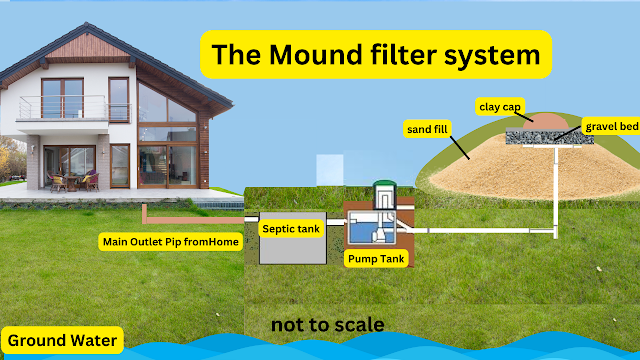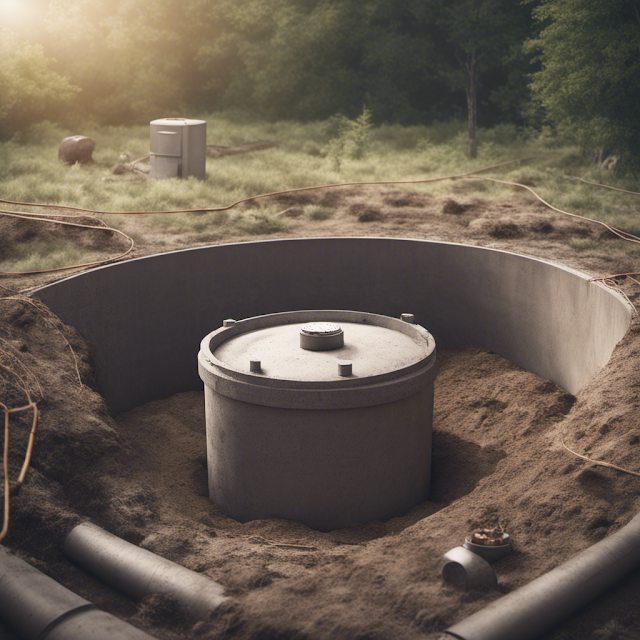Decoding Perc Test Data: How To Interpret Results And Make Informed Septic System Decisions
 |
| Decoding Perc Test Data |
Are you in the process of building a new home or considering installing a septic system on your property? If so, understanding perc test data and how to interpret the results is crucial for making informed decisions.
Decoding perc test data allows you to assess the suitability of your land for a septic system and determine its capacity, ensuring that you make the right choices for your property.
Conducting a perc test involves measuring the rate at which water drains through the soil on your land. This data is then used to determine whether or not the soil can adequately filter wastewater and prevent contamination of groundwater sources.
By the way, like many things, the perc test is just the shortened version of the percolation test.
By interpreting perc test results, you can gain insights into factors such as soil composition, permeability, and absorption rates. Armed with this knowledge, you can make precise determinations regarding septic system design, size, and location that will ensure optimal functionality and minimize potential environmental risks.
So let's dive into decoding perc test data together to help you make informed septic system decisions for your property.
Understanding Perc Tests and Their Importance
Perc tests are a crucial step in determining the viability of installing a septic system on your property, giving you a clear picture of the soil's ability to absorb wastewater. These tests are conducted to measure how quickly the soil can absorb water, which is an important factor in determining if a septic system can be effectively installed.
Perc test regulations vary by location, but they generally require digging multiple holes in the ground and filling them with water to simulate wastewater absorption. The rate at which the water drains from these holes is then measured to determine how well the soil can absorb wastewater.
Understanding perc test results is essential for making informed decisions about septic system installation. If the soil fails the perc test, it means that it does not have sufficient permeability to handle wastewater disposal effectively. This information allows homeowners to explore alternative options such as advanced treatment systems or connecting to a municipal sewer line if available.
On the other hand, passing perc test results indicate that the soil has adequate drainage capacity for a standard septic system.
By interpreting and analyzing perc test data accurately, homeowners can make informed decisions about their septic system installations. It is important to comply with local perc test regulations and consider alternatives if necessary, ensuring that your property has an efficient and environmentally friendly waste management solution in place.
The Process of Conducting a Perc Test
When conducting a perc test, it's important to understand the step-by-step process in order to gain valuable insights for determining the suitability of a location for a septic system.
The perc test procedure typically involves digging test holes at specific locations on the property. These holes are usually around six inches wide and deep, and are dug in areas where the septic system will be installed.
Once the holes are dug, they're filled with water and left overnight to saturate the soil.
The next step in conducting a perc test is measuring how quickly the water drains from the test holes. This is done by filling each hole with a specific amount of water and then timing how long it takes for the water level to drop by one inch.
This measurement is known as the drainage rate or percolation rate, which indicates how well the soil can absorb water. A slower drainage rate suggests that the soil may have poor percolation properties, meaning that it may not be suitable for installing a septic system. On the other hand, a faster drainage rate indicates good percolation properties and suggests that the area may be suitable for a septic system installation.
By following this perc test procedure, you can gather accurate data to make informed decisions about whether or not a particular location is appropriate for a septic system installation.
Interpreting Perc Test Results
To understand if a location is suitable for a septic system, you need to analyze the information gathered from the perc test. The results of the perc test provide crucial insights into the soil's ability to absorb water and determine the size and type of septic system required.
Perc test analysis involves interpreting specific measurements and comparing them to established guidelines. In perc test analysis, two key parameters are considered: the percolation rate and the depth of the water table. The percolation rate measures how quickly water can infiltrate into the soil, indicating its ability to handle wastewater. Guidelines typically specify a minimum percolation rate that is deemed acceptable for installing a septic system.
If the percolation rate is too slow, it suggests that the soil may be compacted or have high clay content, which inhibits proper drainage. On the other hand, if it is too fast, it may indicate sandy or gravelly soil that cannot retain enough water for effective treatment.
Another important factor in perc test analysis is determining the depth of the water table. This refers to how close groundwater sits below the surface of the soil. Guidelines often dictate a minimum separation distance between this level and any proposed drain field or leach field area. If there is insufficient distance between them, effluent from a septic system could contaminate groundwater sources with harmful pathogens and pollutants.
By carefully analyzing these parameters according to established perc test guidelines, you can make informed decisions about whether a particular location is suitable for installing a septic system and what type would be most appropriate given your findings.
Factors to Consider in Making Septic System Decisions
Considering the many factors involved, you'll want to carefully evaluate the information gathered from the perc test to ensure that your chosen location is optimal for installing a septic system.
One important factor to consider is the soil type. Different soil types have varying rates of water absorption, which can greatly impact the effectiveness of a septic system. For example, sandy soils tend to have high infiltration rates and are generally more suitable for septic systems, while clay soils have slower infiltration rates and may require additional measures such as larger drain fields or alternative treatment options.
Another factor to consider is the size of your property. The size of your lot will determine how much space you have available for the septic system components, including the tank and drain field. It's important to ensure that there is enough space on your property to accommodate these components and meet any setback requirements from nearby wells or bodies of water.
Additionally, you'll want to take into account any local regulations or restrictions that may affect your septic system decisions. Some areas have specific requirements for setback distances, minimum lot sizes, or even mandatory connection to municipal sewer systems. Familiarize yourself with these regulations before making any final decisions.
Lastly, it's crucial to consider any potential environmental impacts that may arise from installing a septic system in a particular location. This could include impacts on groundwater quality, nearby streams or lakes, or protected wildlife habitats. Consulting with local environmental agencies or professionals can help you assess these potential impacts and make an informed decision about whether or not a particular location is suitable for a septic system.
By carefully considering these factors and evaluating all available information from the perc test results, you can make informed decisions when it comes to installing a septic system on your property. Remember that each property is unique and what works well for one may not work as effectively for another. Taking the time to thoroughly understand these factors will ultimately lead to a more successful and efficient septic system installation.
.png) |
| check before buying a house |
Making Informed Choices for Your Property
Understanding the factors that impact the effectiveness and suitability of a septic system is crucial for making well-informed choices about installing one on your property. Before making any decisions, it's important to conduct a thorough property assessment to determine if a septic system is suitable for your specific needs.
This assessment should include an evaluation of the size and layout of your property, as well as any potential limitations or challenges that may affect the installation process.
Once you've completed a comprehensive property assessment, the next step in making an informed choice is to conduct a soil analysis. Soil analysis involves testing the soil on your property to determine its composition and drainage capabilities. This information is essential in determining whether or not a septic system can be effectively installed on your land.
Additionally, soil analysis can help identify any potential issues such as high water tables or unsuitable soil conditions that may require special considerations during the installation process.
By conducting both a thorough property assessment and soil analysis, you'll have access to critical data that'll enable you to make informed choices regarding the installation of a septic system on your property.
These assessments provide valuable insights into the unique characteristics of your land and help identify any potential challenges that may arise during installation. Armed with this information, you can confidently move forward with selecting the most appropriate septic system for your needs while ensuring long-term functionality and efficiency.
Frequently Asked Questions
Are perc tests required for all types of properties, or are there certain exemptions?
Perc tests are required for both commercial and residential properties. Not conducting a perc test before installing a septic system can lead to inadequate drainage, environmental pollution, and costly repairs in the future.
How long does a perc test typically take to complete?
The duration of a perc test can vary depending on several factors, such as soil type, weather conditions, and the size of the property. On average, a perc test typically takes about 1 to 2 hours to complete.
Can perc test results vary depending on the time of year or weather conditions?
Yes, perc test results can vary depending on the time of year and weather conditions. Weather impact and seasonal variations can affect soil moisture levels, which in turn affect the percolation rate measured during the test.
Are there any alternatives to perc tests for determining septic system feasibility?
There are alternatives to perc tests for determining septic system feasibility. These include soil morphology assessments, hydraulic conductivity tests, and deep hole tests. Each method has its pros and cons in terms of accuracy and cost-effectiveness.
What are some common mistakes or oversights to avoid when interpreting perc test results?
When interpreting perc test results, be mindful of common pitfalls. Key considerations include avoiding mistakes in calculating absorption rates, overlooking site-specific factors, and failing to consider long-term soil health.
Conclusion
In conclusion, understanding and interpreting the results of a perc test is crucial in making informed decisions about septic systems. The perc test provides valuable data on the soil's ability to absorb water, which directly impacts the design and functionality of a septic system. By carefully analyzing the test results, property owners can determine whether their land is suitable for a septic system or if additional measures need to be taken.
The process of conducting a perc test involves careful planning, site preparation, and accurate measurements. Professionals use specialized equipment to measure how quickly water drains from a specific area of soil. The results are then analyzed based on predetermined criteria set by local regulations or guidelines.
Interpreting perc test results requires an understanding of various factors such as soil type, depth to groundwater, and local regulations. These factors influence the absorption rate of the soil and ultimately determine whether it meets the requirements for a septic system installation. Property owners must also consider other aspects like lot size and topography when making decisions about their septic system.
Making informed choices for your property starts with understanding the perc test data and its implications. By considering all relevant factors and seeking professional guidance, property owners can ensure that their septic systems function efficiently while minimizing potential environmental risks. Remember that investing time in analyzing perc test results will lead to long-term benefits in terms of cost-effectiveness and environmental sustainability.
.png)



.png)





Comments
Post a Comment